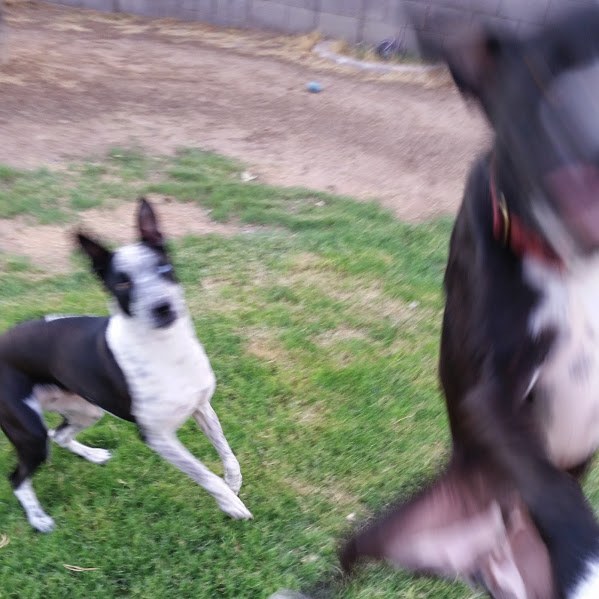One of the first questions we had to ask ourselves before we embarked on our mission to train our dogs was, “What do we want our dogs to know?” The answer to this question will vary for everyone.
It depends on a lot of factors, like which types of activities you want to do with your dogs and where you like to take your dog.
Since I work from home, our dogs spend more time with me than the “average” pet, so many of our “must know” commands are focused on common courtesies: Don’t jump on visitors (still working on that), don’t bark unless there is a threat, don’t roughhouse while I’m on the phone, don’t get under my feet while I’m walking (mostly because I’m clumsy), etc.
But, one of the first things I teach my own pets – no matter what breed or age – is the “drop” command and “easy” command. These commands are very important to me on a personal level because:
- I don’t want them picking anything up off the ground that I didn’t give them (especially now that I also make soap)
- I don’t want them to snap food from my hand, (my dogs have very big teeth).
While these are important to me, there are other commands that are also important. No matter what your situation, whether you’re seeking the coveted “Canine Good Citizen” certification or just hoping you can take your dog into a public park without an incident occurring, these are the top 5 commands that all dogs should know:
1. “No”
As far as I’m concerned, “No” is probably the number one command that all dogs should know. Whether it’s because they are barking, growling, picking up strange food, jumping… there are a million uses for this command and it’s something that every dog should know cold.
I’m sure that many trainers will disagree by saying, “If you train your dog correctly, you’ll never need to use the word ‘No.” They would probably be right. However, not every dog has the benefit of having a professional trainer as a mom or dad, and so I still consider “No” a “first commandment” in our household.

2. “Drop”
This command is very important to know on walks – particularly if you have a very “nosy” dog like a beagle or a Labrador who do all of their exploration by eating or sniffing things they find.
The second you say the word, “Drop”, they should drop whatever is in their mouths.
My own dogs used to be quite good at this – that is, until I made the mistake of playing “Keep Away” with Bree. Lesson learned (for me) that you can’t teach your pet a command, then turn it into a game. Now we are back to square one…
3. “Come”
Every pet parent should have a solid recall for pets. This means that when you call them back, they immediately return.
Whether your dogs are bolting out a door or playing in a park, the goal is to have them stop whatever they are doing and return immediately to you.
You should eventually be able to put your dog into a “stay” command, walk at least 10 feet away, then have your dog come when called. We are working on this now with our own dogs.
While training, you will need LOTS of low-calorie training treats, a collar or harness, and a leash. You may find some extra benefits in picking up a long 10-15 ft lead (also known as a check cord).
One thing we have learned from trainers is that every pet should have an “emergency recall” command. This is the command you would use that your dogs will NEVER fail to respond too. If they are heading into traffic, they should know that your emergency recall is like the Voice of God – nonnegotiable.
4. “Heel”
“Heeling” has different meanings to different people.
Some prefer a tight heel, others prefer a loose-leash heel. Some just want their dog to quit pulling them down the street. Whatever your goal, you should work with the style of your dog and what you’re most comfortable with.
In our case, I’m generally walking three very large dogs at a time. We make it work because we have good relationships. Bree prefers a loose lead heal and since walkways aren’t large enough for 3 big dogs and their person to walk side-by-side, we let her take the lead as long as she remains a “good leader”. This would be a lot easier if she wasn’t so ADD about everything, but she is the most confident of our three, and leader of our “pack” because she is doesn’t “react” to outside stimuli.
Brock and Cheiss prefer to be touching my legs. They stay on a loose leash, but they rarely stray from my side.
My point is: Use your judgement and trust your instinct.
5. “Sit” or “Down” and “Stay”
If you’re taking the “good citizenship test,” you should be able to tell your dog to “stay” or “wait” or simply walk away, giving no instructions to your pet. The goal is to have your dog sit (or lie down) and not come until you tell him.
You should also be able to offer distractions to your dog (most easily done when you’re with others). It could be a ball dropping or a bird flying by, maybe have your friend make a noise, or ask a jogger to run in front of them.
The goal is to have your dog stay sitting or lying down until you give a release command.
We know that these “must know” commands will vary according to each person. So tell us – what is your “absolute, hand of God, all dogs must know” command?

